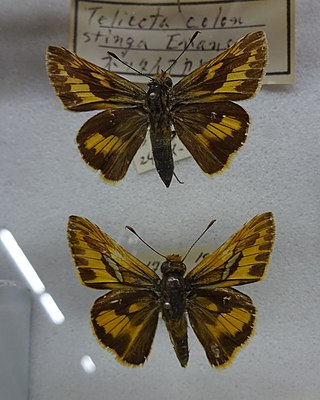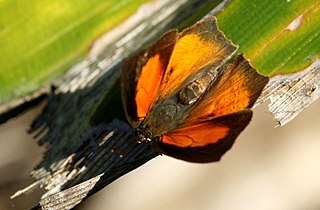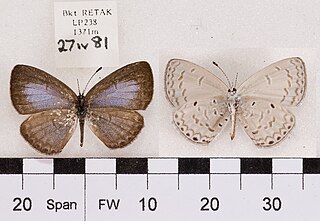
Suastus gremius, the Indian palm bob or palm bob, is a butterfly belonging to the family Hesperiidae. It is found in the Indomalayan realm.

Telicota colon, commonly known as the pale palm dart or common palm dart, is a butterfly belonging to the family Hesperiidae found in India to Australia.

Abaratha ransonnetii, commonly known as the golden angle, is a butterfly belonging to the family Hesperiidae. It was first described by Baron Cajetan von Felder in 1868.

Jamides bochus, the dark cerulean, is a small butterfly found in Indomalayan realm that belongs to the lycaenids or blues family. The species was first described by Caspar Stoll in 1782.

Vindula erota, the common cruiser, is a species of nymphalid butterfly found in forested areas of tropical South Asia and Southeast Asia.

Ionolyce helicon, the pointed lineblue, or bronze lineblue, is a small butterfly found in the Indomalayan realm that belongs to the lycaenids or blues family.

Amblypodia anita, the purple leaf blue or leaf blue, is a lycaenid or blue butterfly found in South Asia and Southeast Asia, including Sri Lanka, India, Myanmar, Malaysia, and Java. The species was first described by William Chapman Hewitson in 1862.

Arhopala amantes, the large oakblue, is a species of lycaenid or blue butterfly found in Asia.

Arhopala abseus, the aberrant oakblue or aberrant bushblue, is a species of lycaenid or blue butterfly found in Asia.

Arhopala bazaloides, the Tamil oakblue, is a species of lycaenid or blue butterfly found in Asia. The Tamil oakblue is found India in, Myanmar, Sri Lanka and Thailand.

Zinaspa todara, the silver streaked acacia blue, is a species of lycaenid or blue butterfly found in South Asia.

Zesius chrysomallus, the redspot, is a species of lycaenid or blue butterfly found in Sri Lanka and India.

Pratapa deva, the white royal, is a lycaenid or blue butterfly found in the Indomalayan realm. The species was first described by Frederic Moore in 1857.

Tajuria melastigma, the branded royal, is a species of lycaenid or blue butterfly found in the Indomalayan realm.

Horaga onyx, the common onyx, is a species of lycaenid or blue butterfly found in the Indomalayan realm.

Deudorix epijarbas, the cornelian or hairy line blue, is a species of lycaenid or blue butterfly found in south and southeast Asia from India to Fiji, including the Philippines, and also the tropical coast of Queensland in Australia. The species was first described by Frederic Moore in 1857.

Curetis acuta, the angled sunbeam, is a species of butterfly belong to the lycaenid family. It is found in Indomalayan realm. Curetis acuta is sexually dimorphic, the sexes differing in dorsal coloration of the wings, however their ventral wings are similar and of silver color which reflects sunlight. The reflection of light by silver ventral wings plays a role of signalling during flight, camouflage while at rest or during hibernation, and lowering body temperatures by reflecting the sunlight.

Zeltus is a butterfly genus in the family Lycaenidae, the blues. It is monotypic containing the species Zeltus amasa, the fluffy tit, a small butterfly found in Indomalayan realm. The butterfly is found in India, specially the Western Ghats, Sikkim to Assam. It can also be found in Myanmar, Thailand, West Malaysia, Sumatra, Borneo, Singapore, Java and the Philippines.

Monodontides musina, the Swinhoe's hedge blue, is a butterfly of the family Lycaenidae. It is found in South-East Asia, including India.
Phalacra acutipennis is a moth in the family Drepanidae. It was described by Charles Swinhoe in 1903. It is found in the Khasi Hills of India.

















